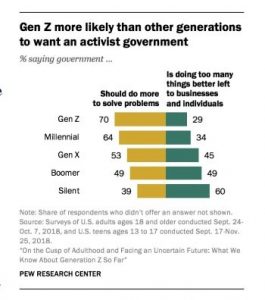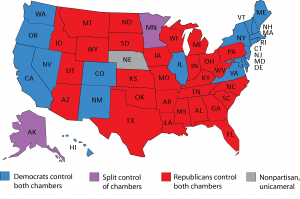At The Cook Politial Report, Amy Walter addresses the critical challenge Democrats will be facing in November: “So, which of these things— the way he has dealt with individual issues like health care, COVID or the economy or the way he has conducted himself as president — will be the most important for swing voters in November?…The challenge in answering that question is that we really have no idea which one of these things is going to be dominating our attention this fall. Will we be dealing with a ‘second wave’ of COVID infections, overstressed hospitals and climbing death rates? If so, it’s hard to see how Trump’s handling of the crisis and health care won’t be at the top of the priority list for voters. But, what if we have actually been through the worst of it? If that’s the case, it’s easy to see that efforts to revive the economy will be the topic that is getting the most attention.”
In his article, “The False Dichotomy” at Current Affairs, Nathan J. Robinson beings some needed clarity to the discussion of economic policy during the pandemic: “The United States has done an absolutely abysmal job of protecting people’s employment. The “paycheck protection program” has been an administrative nightmare, funneling money to companies that don’t need it and saddling small businesses with new debt. The government could have simply paid salaries during the crisis, but a choice was made not to do this, in part because people in government have a pathological hatred of “handouts” and would rather other people die needlessly by the thousands than give an inch on their ideology. Republican Senator Lamar Alexander, for example, said that there is simply “not enough money” to help people through the crisis. This is false; the U.S. government prints its own money. What he is saying is not that there is not enough money, but that he personally does not want the government to spend the money. And instead of giving a reason (the reason is free market Social Darwinist ideology that sees helping the vulnerable as rewarding weakness) he has to pretend it is impossible…If we were a sensible country, what we would instead be asking is: How do we stay locked down as long as public health experts think is necessary, while mitigating the economic consequences?”
David Atkins makes the case that “We Need to Speak Honestly About the GOP’s Evolution Into a Conspiracy Cult” at The Washington Monthly: “Unfortunately, the modern Republican Party’s abdication of seriousness, good faith and reality-based communications or policy-making has stretched even the most open-minded analyst’s capacity for forced balance. Donald Trump’s own inability to string together coherent or consistent thoughts has led to a bizarre normalization of his statements in the traditional media, as journalists unconsciously try to fit his rambling, spontaneous utterances into a conventional framework…Go to any conservative event and you’ll notice a shift from even the raucous detached weirdness of Tea Party rallies. They feel less like political events than cult rallies. Cult experts like Steven Hassan have taken note of this, calling it exactly what it is: a cult built around manufactured realities, shared grievances and us-against-them insular extremism. The increasing dependence of Republican politicians on a shrinking, embattled white evangelical base already given over to faith-based belief systems and racism-tinged “city on a hill” ideology has only exacerbated the phenomenon…It’s long past time for even the venerable pages of the New York Times and the Washington Post to start calling this what it is, and stop normalizing it as standard partisanship. It is deeply dangerous in a democracy whose constitution functionally guarantees a two-party system, for one of those two parties to become a conspiracy cult.
Much of the recent buzz about Biden’s likely running mate choice centers on Sen. Elizabeth Warren. At CNN Politics Greg Krieg and Dan Merica do a good job of explaining why Warren would add policy gravitas and progressive cred to the Democratic ticket. They point out that she is the leading choice of Sanders supporters, and that’s a bridge Democrats will need in November. But Krieg and Merica don’t address the downside risk — that Warren joining the ticket would likely cost Democrats a much-needed U.S. Senate seat, since Massachusetss has a Republican Governor who would pick her replacement, at last for a while. And it is unclear what effect Biden picking Warren would have on African American voter turnout for the Democratic ticket, also a significant concern.
Charlie Cook discusses “What Keeps Democrats Up at Night,” also at The Cook Political Report, and notes, “Democrats risk a perception of being one-dimensionally pro-lockdown, as if reopening was a simple matter of throwing a giant national on-off switch, an exclusive focus on public health above everything else, suggesting that the abilities of families to get back to work or have a life is of secondary or tertiary interest. While it is certainly true that economic well-being cannot be restored without addressing the more immediate health challenge of the coronavirus, the reality is that all Americans are not similarly situated. A one-size-fits-all policy for parts of the country or even entire states strikes some as arbitrary…The danger in both small town and rural America, as well as among working-class whites, is that this can play into a form of grievance and identity politics that could tar the Democratic Party as caring only about those who live in or near cities and along the coasts.”
“A federal judge on Sunday dismantled Florida’s restrictive felon voting rights law in a ruling that could open the door to hundreds of thousands of new voters being added to rolls just ahead of the 2020 presidential election,” Gary Fineout reports at Politico. “U.S. District Judge Robert Hinkle declared key portions of the state’s felon voting law unconstitutional, ordering the state to put in place a new process that would help people register to vote in the state…Hinkle’s ruling could lead to a major addition to the state’s voting rolls just months before the election in the battleground state…The decision comes nearly a year after the Republican-controlled Florida Legislature passed the law that requires people with felony convictions to pay all outstanding court debts in order be eligible to vote. Legislators passed the bill after voters approved Amendment 4 to the state constitution, which aimed to end the state’s lifetime ban on voting for most ex-felons…Hinkle’s ruling did not completely strike down the law, but the judge asserted that requiring people with felony convictions to pay off costs and fees violated the U.S. Constitution’s ban on poll taxes.”
Politico’s Holly Otterbein reports on a warning for Democrats from Pennsylvania: “Pennsylvania could determine the presidency. But it might not be clear for days who won the state on Nov. 3…Election officials throughout the critical battleground, which is implementing no-excuse mail-in voting for the first time ever amid a pandemic, say they are unlikely to finish counting those ballots the night of the general election…Less than two weeks away fromPennsylvania’s primary, some state election officials said they lack the funding and staff needed to handle the massive influx of mail-in ballots they’ve received for that race. They also said the fact that they legally can’t start counting those ballots until the morning of Election Day is complicating matters. In addition to delaying a final tally, the chaos and confusion could sow distrust ahead of the general election and give fodder to those seeking to discredit its results…“We don’t just have a perfect storm. We have perfect storms,” said Republican Al Schmidt, one of the three Philadelphia city commissioners who oversee elections here. “We have new voting technology. We have an election reform that pushed back all the deadlines. And we have mail-in ballots and the pandemic.””
At The Daily Beast, Michael Tomasky warns, “There was a terrifying piece in the Times on Sunday laying out all the different moves he could pull to steal the election that his opponents are war-gaming to prepare for and counter. One little nugget from it: Trump could issue orders that impact cities in battleground states like “declaring a state of emergency, deploying the National Guard or forbidding gatherings of more than 10 people.”…Everyone knows he’ll cheat. Even his supporters know he’ll cheat. His cheating is one of the things they love about him…Here’s one of the scenarios, with Tomasky’s comments: “Imagine, first, an Electoral College tie, 269-269. Yes, it can happen. Under the 12th Amendment, a tie goes to the House, which votes for the next president. Easy-peasy, right? The Democrats control the House, so President Biden, your day has come…Not so fast. First of all, it’s not the current Congress that votes, it’s the next one, the one the nation will elect on Nov. 3 (yes, I’m correct about this). OK, but that Congress is still likely to be Democratic, so what’s the problem? Here’s the problem. The 435 members of the House don’t vote as individuals. They vote as state delegations, each delegation getting one vote. That’s right. So for this vote, Lynne Cheney (Wyoming’s lone legislator) will have a voting power equal to that of the 45 California Democrats (and seven Republicans). Let that sink in. Cheney’s vote on this matter would carry more than 50 times the weight of Nancy Pelosi’s.”
On a more optimistic note, Tomasky also reports “A Surprising Sign of a Democratic Revival in Ohio” and observes: Some numbers from this year’s primary suggest—I don’t want to go too hard here; suggest—that something very interesting might be happening in the Buckeye State, and it’s not good news for Team Orange.” Tomasky notes that Democrats did much better than expected in Ohio’s April primaries, including Democrats requesting more absentee ballots in a historically-Republican district (OH-12) and “8,800 R to D switchers.” Tomasky notes also that “Turnout in the Democratic primary last month was higher than Republican primary turnout for the first time since 2008. And it was a lot higher—more than 860,000 votes to about 680,000.”










